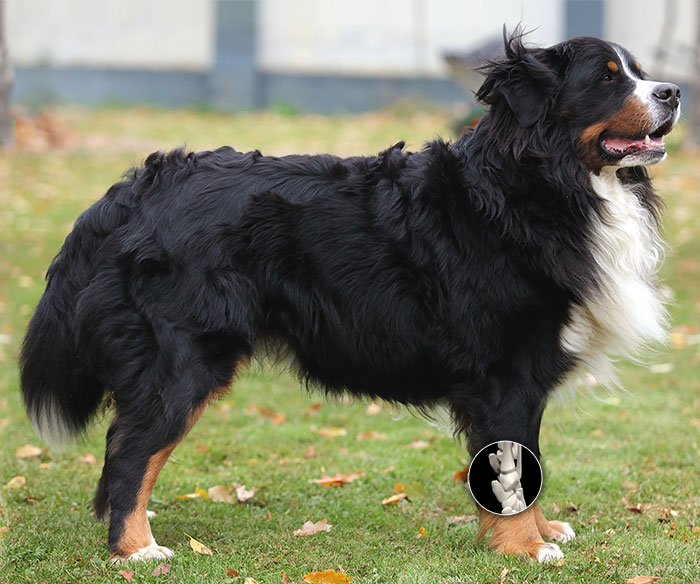


SERVICES
Canine Forelimb/Carpus Injuries

The bones of the forelimb and carpus (wrist) joint can be prone to many orthopedic issues. Diagnosis and treatment of these disorders can be very frustrating and complicated. Our extensive experience has given us the opportunity to identify and treat many of these conditions with great success. From angulation in the forelimb bones to hyperextension injuries, we have the ability to address forelimb and carpal conditions with confidence.
Click on the procedure below to learn more.
Arthrodesis
Arthrodesis is the surgical elimination of joint motion and, ultimately, bony fusion of joint surfaces. Carpal Arthrodesis is considered a salvage procedure for patients when other treatments will not restore normal, pain-free joint function. It is often used to treat pets with hyperextension injuries which have caused severe palmar ligament damage. This ligament does not tend to heal well even with splinting and often needs to be fused in a functional position for the pet to regain some useful function of the limb. While the procedure it not without complications, it does provide a good overall prognosis in pets with extensive damage.
Angular Deformity
Some patients that present to us that have either a congenital defect or an injury to the growth plate of one of their bones. These pets have subsequently developed an angulation of the bones, often to the lower portion of the leg. Because the deformity changes the orientation of the limb in some way, it also changes the angle of forces directed through the joint and limb structures. This can lead to abnormal wear of the cartilage surfaces, predisposes the pet to dislocation or even causes the limb to become non-functional.
Depending on the severity of the angulation, surgical correction may be indicated. Surgery can, in many cases, improve limb function however the limb will never be completely normal. Correction can involve a variety of procedures including BODPUO (Bi-Oblique Dynamic Proximal Ulnar Osteotomy) and the type that is ultimately performed is dependent upon the needs of each individual patient.
Fracture Repair
At Packerland Veterinary Center, we are able to handle the simplest of broken bones, all the way through the most complex of fracture presentations. Dr. Dunbar's extensive training and orthopedic experience have given him the tools to provide the best care possible for fractures of all shapes and sizes.
There is no cookie cutter method to approach every patient with a broken bone. We have to be flexible in the methods that we have available to approach each individual situation. Some fractures may heal adequately with external support such as casting, while others require elaborate bone plate and screw repairs along with bone grafting techniques. The trick is to know what works with each fracture presentation, and to be able to perform the procedure in a manner that will give the patient the best recovery possible.
Stem Cell Therapy (SCT)
This procedure involves surgically harvesting fat tissue from your pet and then processing that tissue in house to remove the stem cells. The stem cells are then "activated" with our special equipment and later the same day we can inject the cells back into specific areas of the patient where needed. Stem Cells will not change any structural issues that have lead to any current carpal problems, but can help with the arthritis that has formed in the joint by helping to reduce inflammation and rebuild the joint cartilage surface, making the pet more comfortable overall. In many cases, SCT can often be used in conjunction with surgical treatment to maximize overall results.
For more in-depth information about Stem Cell Therapy, click here.
Platelet Rich Plasma Treatment (PRP)
Popular in human orthopedics, PRP therapy utilizes a patient's own blood plasma as an all-natural, drug free pain relief option. Once activated by our specialized equipment, the PRP works to initiate and accelerate tissue repair and reduce localized inflammation. PRP can be utilized in a variety of conditions, but most often is used to treat the inflammation present in injured joints and tendons. While it does not provide a more long-term regeneration of cells like Stem Cell Therapy, PRP can be an affordable short term solution to treat pain and inflammation in our patients.
PRP treatment begins with a blood draw from the patient. The blood is then specially processed to bring out the PRP mix of concentrated serum and platelets. Patients then receive light sedation while the PRP is injected into the specific area or areas needing treatment. Any additional PRP can be frozen and saved short-term for future treatments that may be needed in the months following. While each pet's response to PRP is different, we have seen great short and longer term results utilizing this therapy.


